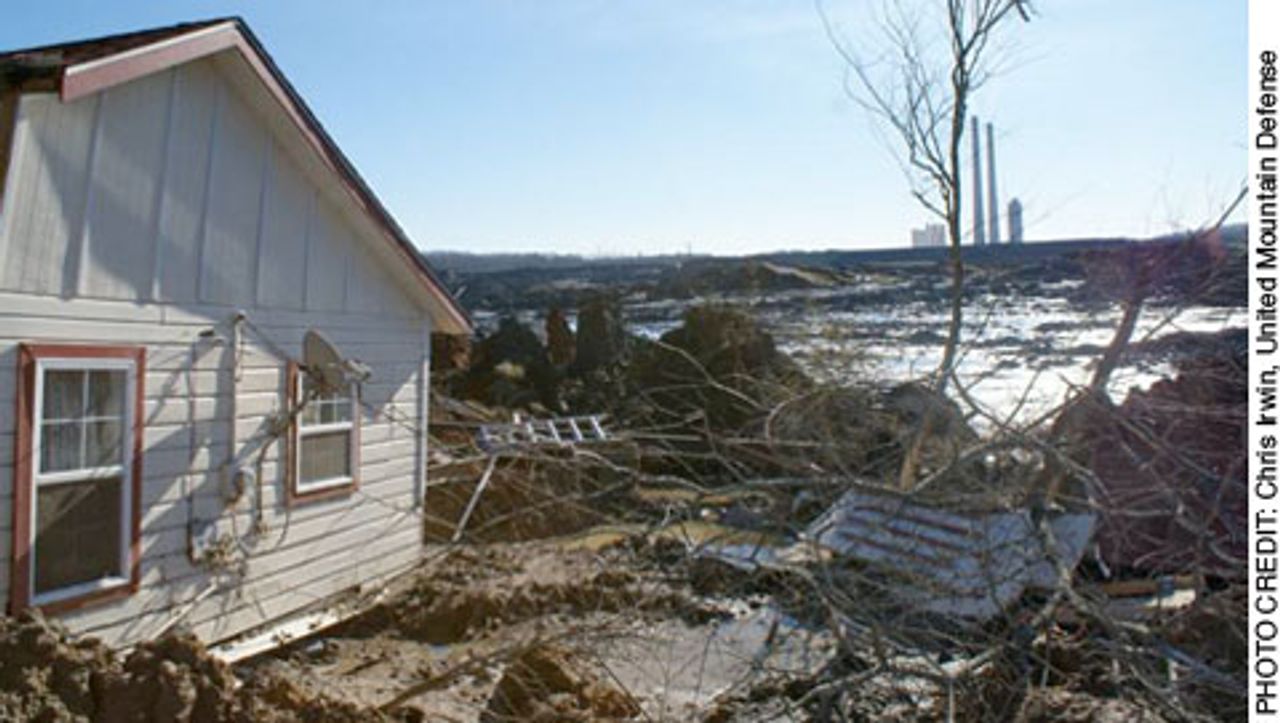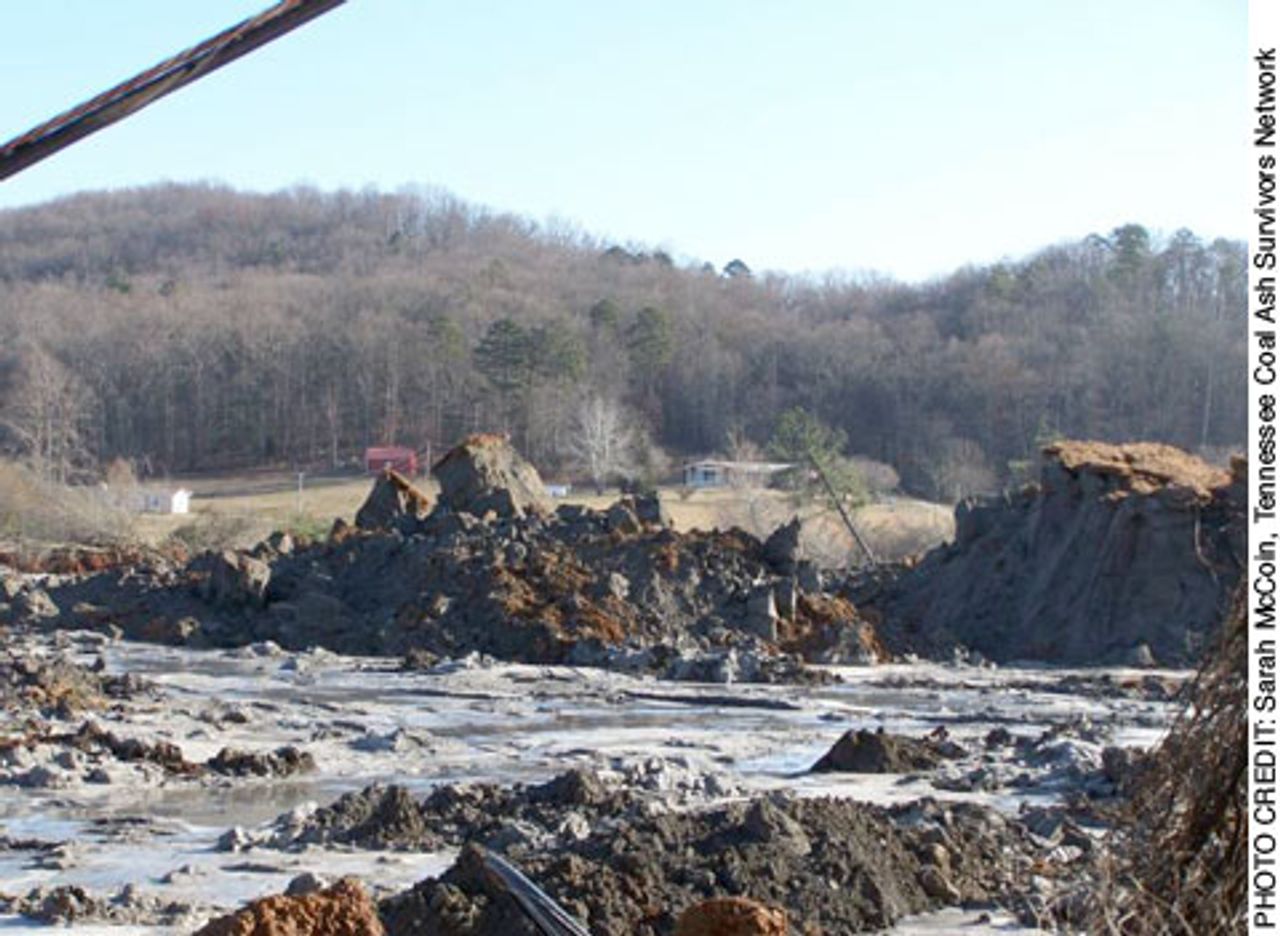On February 12, the Tennessee Valley Authority board met for the first time since the December 22, 2008 collapse of an earthen damn at their Kingston Fossil Plant. The collapse allowed 1.1 billion gallons of toxin-filled coal ash waste to pour over some 300 acres of farm and residential land and into two local rivers. (See “Worst coal ash spill in US history ruins huge area in Tennessee”)
 Home surrounded by coal ash spill
Home surrounded by coal ash spill
In a press release, TVA stated, “Current estimates on clean-up costs range from $525 million to $825 million, depending on the method of ash disposal that is assumed. The range does not include costs for items such as regulatory actions, litigation or long-term environmental remediation.”
TVA President Tom Kilgore said the spill was worse than the agency’s public relations staff initially had suggested. “It was a ‘catastrophe,” he said, contradicting an internal talking-points memo, obtained by the Associated Press, in which the description of the disaster had been changed from “catastrophic” to a “sudden accidental” release, apparently to make it sound less devastating.
The same memo had also been edited to remove “risk to public health and risk to the environment” as a reason for measuring water quality, and eliminated a reference to the potential of an “acute threat” to fish.
After a much smaller blowout in a different section of the coal-fired Kingston power plant’s massive wet-storage landfill in late 2003, and a subsequent TVA investigation, several repair alternatives were suggested ranging in cost from $480,000 to $25 million. TVA chose to ignore their own report and addressed the 2003 leak as well as ones in 2006 and in 2007 with cheaper—and far less effective—methods.
As a result, the cleanup of 50 years worth of formerly stored toxic sludge will take at least a year to complete. The effects on the people, economy, and environment of Roane County, Tennessee will last for untold years to come.
Four lawsuits have already been filed against TVA, with notices of intent to file recorded for three others. The utility has retained the firm of Shook, Hardy and Bacon, noted for its defense of tobacco and pharmaceutical companies, to represent them.
The US Environmental Protection Agency has notified TVA that the spill violates the Clean Water Act. The Tennessee Department of Environment and Conservation is conducting an investigation that could result in more fines and increased regulatory requirements.
If the planned dredging of the Emory River as part of the clean-up stirs up pollutants, such as PCBs and mercury known to exist there prior to the spill, additional remediation would be likely.
 Coal ash waste from last December's disaster at TVA's Kingston Fossil Plant
Coal ash waste from last December's disaster at TVA's Kingston Fossil Plant
The utility has agreed to purchase from 19 families’ properties—covering some 93 acres with a total appraised value of $2.5 million—inundated by the coal combustion waste materials and has agreements pending with another 18. Three homes were totally destroyed when the dyke burst.
The Knoxville News Sentinel reported that by early February TVA had received 360 damage claims involving real estate and 209 involving health-related issues.
Earlier this month a federal judge accelerated the deadline for TVA to improve air pollution controls at a cost of $1.8 billion for four coal-fired plants—three in Tennessee and one in Alabama—that have been spewing emissions into North Carolina. Additionally, TVA must reduce emissions at seven other plants by 2013 with costs in the neighborhood of $3 billion.
Less than three weeks after the catastrophe at the Kingston plant, a smaller coal ash spill occurred at the TVA plant in Widows Creek, Alabama.
TVA, the nation’s largest public utility with nearly 9 million customers in seven southeastern states, is self-financing. Its options for covering the costs of the Kingston and Widow’s Creek spills and various lawsuits and fines include insurance, selling off assets, or transferring the cost to its customers.
Two Tennessee congressmen had hoped, but failed, to have $25 million—a drop in the toxic bucket given the possible $825 million price tag—added to the federal stimulus bill to help pay for the Kingston clean-up. “I know TVA is committed to paying for the cleanup, but they can’t borrow money because of the cap on their debt levels,” said Zach Wamp, a Republican, “so it’s going to be passed on to ratepayers.”
While the cost per ratepayer for the Kingston spill alone calculates to be about $90, when expenses from fines, lawsuits and mandated upgrades are included the cost per ratepayer could climb to over $650.
According to Representative Wamp, TVA has been tasked by Congress to provide land and water stewardship—although Congress quit funding TVA’s conservation efforts over 10 years ago. Stewardship does not appear to be TVA’s strong suit.
The 50 years worth of formerly stored coal ash waste, currently devastating the Roane County environment, includes an horrendous toxic soup of arsenic, selenium, cadmium, lead, radium, mercury, and other dangerous elements which can cause various cancers, birth defects, and other serious health problems if ingested by humans, wildlife, and plant life.
Samples taken by Duke University, the Environmental Integrity Project and United Mountain Defense have found alarmingly high levels of arsenic, radium, and other heavy metals in the immediate area of the spill. Reduced levels were found farther downstream. So far, no exceedances of acceptable EPA levels have been found in the drinking water.
If the wet ash were to dry it could enter humans and other organisms as airborne dust, which—in addition to other toxic materials—contains sharp-edged bits of silica. Workers in New York City cleaning up debris after 9/11 were sickened by silica in the building materials dust.
Footage shot earlier this month by United Mountain Defense appears to show an incidence of airborne fly ash dust in an area about 40 feet high and 80 feet wide. TVA officials said it must have been fog.
Regardless of the amount TVA spends on cleaning up the spill over the next year or so contaminates have, and will, find their way into the people and environment of Roane County and beyond. Despite any levels established by the EPA as “acceptable” for human consumption, scientific knowledge of the impact of various toxins remains limited. It is widely accepted, however, that such contaminates are linked to diseases such as cancer, autism, Alzheimer’s and various allergies.
The Kingston and Widow’s Creek spills have sparked fears wherever wet coal ash is stored, particularly in Indiana, West Virginia, and recently in North Carolina, where alarming levels of arsenic were found in the water outside Progress Energy’s power plant in Skyland.
An analysis by the Environmental Integrity Project, indicates a total of 13 states “have at least three coal-fired power plant ‘surface impoundment’ dumping sites on the six 50 worst toxic chemical lists Indiana, 11 dumps; Ohio, eight dumps; Kentucky, seven dumps; Alabama, seven dumps; Georgia, six dumps; North Carolina, six dumps; West Virginia, four dumps; Tennessee, four dumps; Illinois, three dumps; Michigan, three dumps; Pennsylvania, three dumps; Florida, three dumps; and Wyoming, three dumps.”
Various coal ash byproducts can be resold and recycled as gypsum for wallboard, granules for roofing shingles, grit for sandblasters, filler material for recreation areas and industrial parks, and for use in items ranging from cosmetics to bowling balls. The EPA has approved the use of coal ash for highway construction in cement, concrete, and asphalt, for embankments and structural fills, and for snow and ice control.
“Tons of fly ash are routinely added to soil to nourish vegetables, peanuts and other crops,” states a recent article in Scientific American. “However, fly ash contains various amounts of toxic metals. And studies have shown that food crops grown in large amounts can soak up hazardous concentrations of arsenic.
“Because it is not classified as hazardous waste under Environmental Protection Agency standards, there is no federal supervision of its use in agriculture.”
Battlefield Golf Club in Chesapeake, Virginia was built with 1.5 million tons of fly ash. Originally considered one of the great successes of recycling coal combustion waste, it now stands as a prime example of the worst possible toxic consequences of reusing coal ash. City water tests found arsenic and lead levels exceeding drinking water standards in groundwater wells nearby the golf club soon after its completion.
“We need to learn a lesson from what happened at Kingston, Tennessee,” said House Natural Resources Committee Chairman Nick Rahall, a West Virginia Democrat. “I believe we have a ticking time bomb on our hands.”
“The electric utility industry generates 131 million tons of coal ash each year. Yet the disposal of this massive amount of material is the subject of a patchwork of state regulation, some very good, some not so good, some bordering on the nonexistent.”
Rahall has introduced a bill that would place federal standards on coal ash storage similar to those currently in effect for the storage of coal slurry, the wet waste created by plants that prepare the coal for burning.
EarthJustice, an environmental group, points out that Rahall’s bill tasks the Office of Surface Mining, rather than the EPA, with regulating the disposal of toxic coal combustion waste and that “The bill seeks to regulate, rather than ban, the dangerous practice of mixing pollutant-laden ash with water and dumping the dangerous mixture into ponds, where toxins can more easily migrate and contaminate groundwater supplies. For years, environmental groups have called for a phase-out of coal ash ponds in favor of safer alternatives: dry disposal in landfills and certain types of recycling.”
Attempts have been made to regulate coal ash as a hazardous waste since Congress first raised the prospect in 1980. Complaints from the utilities and coal industries have caused those attempts to fail.
The Tennessee Valley Authority is a federally owned corporation created by congressional charter in 1933 to serve the energy and other economic needs of a region particularly impacted by the Great Depression. The TVA has come under increasing pressure since the 1990s to compete as the electric-utility industry moved towards deregulation, cutting its costs by nearly $800 million a year and reducing it workforce by more than half.
The authority has close ties to energy interests, with influential business figures as well as leading Democratic and Republican politicians included in its top management. Current TVA president Tom Kilgore is a longtime utility executive and engineer, hired in 2005 from Progress Ventures, a subsidiary of North Carolina-based Progress Energy, where he served a president and CEO.
Mike Duncan was elected chairman of the TVA board in a 4-3 vote February 12. Duncan, who served as the chairman of the Republican National Committee from January 2007 through January 2009, was nominated to the TVA board by George W. Bush in 2006. Duncan is the CEO of Community Holding Company in Inez, Kentucky. Duncan replaced outgoing chairman William B. Sansom, who is the chairman and CEO of wholesale grocery distributor H.T. Hackney.
